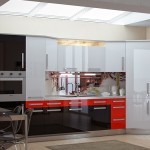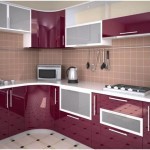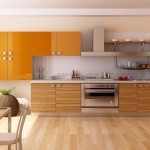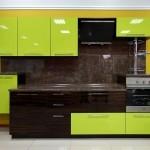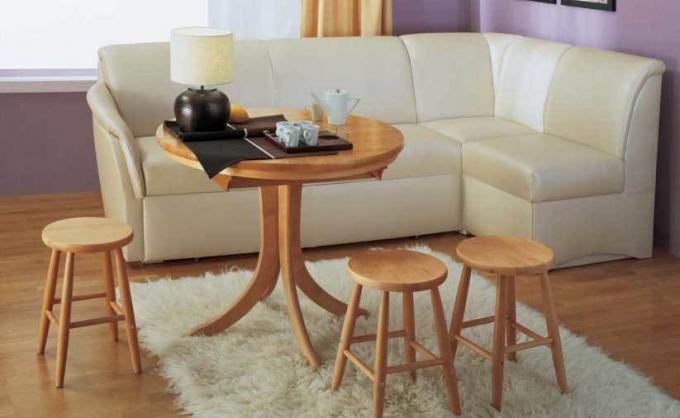Content
- 1 What is acrylic facade
-
2 Pros and cons of the material
- 2.1 Advantages
- 2.2 disadvantages
-
3 Comparison with other materials
- 3.1 PVC film
- 3.2 Plastic
- 3.3 Painted surfaces (enamel)
- 4 Edge options for acrylic facades
- 5 Finally
Acrylic kitchen fronts have long been part of the modern interior. What are they, and what is the reason for such popularity? You will find answers to these questions in today's material.

Acrylic kitchen fronts have become an integral part of the modern kitchen interior
What is acrylic facade
Acrylic (aka polymethyl acrylate) is a thermoplastic material that is produced by polymerization of monomers. Kitchens with acrylic fronts are becoming more and more popular, the demand for them is growing from year to year. What are they like?

The facades are based on MDF boards, which are covered with a special acrylic film
Acrylic kitchen facades are made on the basis of MDF boards, on which acrylic sheet material is applied. Strong adhesion of materials to each other is ensured by exposure to high temperatures.

Pressing and exposure to high temperatures provides the material with strength
After applying the film, the boards are cut into pieces according to the size of the headset. Their edges are either processed with an ABS edging, or closed with an aluminum frame.
There are two types of coverage:
- Unilateralwhen the front side is decorative plastic (acrylic), the back side is white plastic.
- Double-sidedwhen both sides are covered with decorative plastic.

The surface can be finished with gloss either on both sides, or only from the front
Pros and cons of the material
Acrylic facades for the kitchen have earned their popularity for a reason. They have a lot of advantages, although there are some drawbacks. Let's consider these two points in more detail.

Acrylic coating has an impressive list of advantages
Advantages
Acrylic kitchen facades have a number of useful characteristics. Among them are:
- Strength. Acrylic kitchen fronts are quite resistant to mechanical damage and damage, which is very important in the kitchen.
- Safety. The materials used in the manufacture of such structures are absolutely harmless to human health. They do not contain harmful volatile components, resins, carcinogens and other unpleasant substances.

The discussed material is not only very durable, but also safe for humans.
- Long service life. Provided that the material is properly cared for, acrylic kitchen fronts can serve their owners for more than a decade. However, their appearance will not change at all.
- Moisture resistance. Even a high level of humidity is not capable of provoking rotting or the formation of mold on the surface.

With proper care, facades will last more than a decade
- A wide range of. Such facades are presented on the market in a wide range of colors, with more than 20 shades (and this is only one color). At the same time, the tonality of the facades turns out to be very rich, which allows them to be used as a highlight of the kitchen interior.
- Ease of cleaning. The smooth, perfectly flat surface will not create any difficulties during the cleaning process. The main thing is not to use aggressive acid-based cleaning agents during the cleaning process.
- UV resistant. Even constant exposure to sunlight cannot cause acrylic to darken or lose its original brightness.

The instructions for the care of the material are simple - the main thing is not to use aggressive cleaning agents.
disadvantages
Before deciding to buy acrylic facades, you need to find out not only about their advantages, but also disadvantages. The disadvantages of such coatings include:
- Frequency of contamination. You will have to take care of acrylic almost daily - you can see the smallest drops of water and splashes of fat, as well as fingerprints.

A rather big price - another drawback of acrylic
- Inability to bend material. If you are a fan of sleek, concave headsets, then you should consider buying a different material. Acrylic cannot be bent, therefore facades made of it can only be straight.
- Strong gloss. The gloss of such a coating, despite its showiness, may not suit everyone.

Strong gloss gloss is not suitable for everyone
Comparison with other materials
To make sure that acrylic kitchen fronts are exactly what you are looking for, it will not be superfluous to compare them with some other materials. This will help you make a more informed decision. Let's take a closer look at some of the types of coating for kitchen facades, touch it, so to speak, with our own hands.

Before choosing facades for the kitchen, you should familiarize yourself with other options
PVC film
Polyvinyl chloride (PVC) film is applied to the substrate using a vacuum press.
- pros. This is an inexpensive option that offers a huge variety of textures and colors for every taste. In addition, the film is quite resistant to various cleaning agents and is durable.
- Minuses. The film will quickly lose color brightness, fading in the sun. This option is not for kitchens with south-facing windows. In addition, it does not tolerate moisture and heat well.

PVC film is a relatively inexpensive option that cannot boast of UV resistance
Plastic
Such facades are created by pasting MDF boards with paper-laminated plastic (HPL). As a result of processing, the plastic acquires greater strength.
- pros. It perfectly tolerates temperature changes, moreover, it is resistant to ultraviolet radiation. Not subject to abrasion and cracks, it has a wide range of colors.
- Minuses. The main disadvantage is fingerprints, which will require special detergents from housewives. The surface can be damaged with powder substances, so you should refuse to use them.
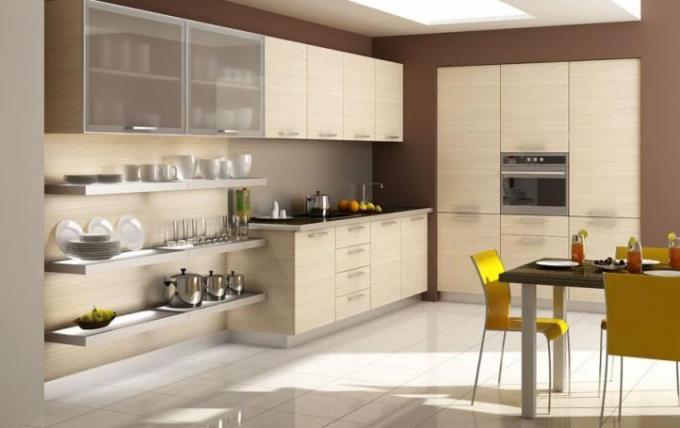
Plastic tolerates moisture well
Painted surfaces (enamel)
The production technology is as follows: the surface of MDF is primed, after which several layers of enamel are applied to it. After they dry, they are sanded, varnished and polished.
- pros. A huge variety of colors, some of which are quite rare, such as metallic, mother of pearl, chameleon, cracolette, etc. Painted facades for the kitchen, like acrylic, they are environmentally friendly, therefore safe. Are not subject to fading (fading), do not absorb grease and various fumes
- Minuses. Quite high cost. Fingerprints will be clearly visible on the surface, which can only be removed with a gentle detergent.

Painted surfaces offer the widest range of colors
Edge options for acrylic facades
Since the facade of the kitchen is a multilayer material, the question of choosing a finish for its edge becomes natural. For acrylic boards, you can use one of the proposed options.

The edge of the facades can be processed by post morphing, gluing PVC foil or installing aluminum profiles
- Post morphing. This edging option can only be used if the surface is finished with acrylic foil.
- PVC or acrylic edging. It is better to opt for the second option - it is more resistant to moisture, and practically does not differ in cost from PVC.
- Aluminum frame. Ideal for hi-tech or techno style. Thanks to the aluminum frame, the facades are maximally protected, which prolongs their service life.

Aluminum edging is the most durable option to extend the life of the coating
Finally
Acrylic kitchen façade is the perfect solution for modern kitchens, high-tech or eclectic interiors. Now you know about the main advantages of such a coating and can compare them with other materials.
Look for more ideas for implementation in the video and photo in the article.
Gallery




















